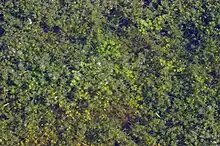Lepidocaris
Lepidocaris rhyniensis is an extinct species of crustacean. It is the only species known from the order Lipostraca, and is the only abundant animal in the Pragian-aged Rhynie chert deposits. It resembles modern Anostraca, to which it is probably closely related, although its relationships to other orders remain unclear. The body is 3 mm (0.12 in) long, with 23 body segments and 19 pairs of appendages, but no carapace. It occurred chiefly among charophytes, probably in alkaline temporary pools.
| Lepidocaris Temporal range: | |
|---|---|
 | |
| Artist's restoration | |
| Scientific classification | |
| Domain: | Eukaryota |
| Kingdom: | Animalia |
| Phylum: | Arthropoda |
| Class: | Branchiopoda |
| Order: | †Lipostraca Scourfield, 1926 |
| Family: | †Lepidocarididae Scourfield, 1926 |
| Genus: | †Lepidocaris Scourfield, 1926 |
| Species: | †L. rhyniensis |
| Binomial name | |
| †Lepidocaris rhyniensis Scourfield, 1926 | |
Biostratigraphy and taxonomy
All the known specimens of Lepidocaris rhyniensis have been excavated from the Rhynie chert deposits in Aberdeenshire, Scotland, which is a famous Lagerstätte, or site of exceptional preservation. Lepidocaris is the only abundant animal in the deposits,[1] and is likely to be responsible for many of the frequent coprolites found in the rocks.[2]
Lepidocaris was first described by D. J. Scourfield in a 1926 paper in the Philosophical Transactions of the Royal Society B.[3] Scourfield could not accommodate his new genus in the same order as its closest relatives – the Anostraca – so he erected a new family and order for Lepidocaris alone: Lepidocarididae and Lipostraca, respectively.[4] Until 2003, when Castracollis was described, Lepidocaris was the only crustacean known from the Rhynie chert.[5][6]
Description

Lepidocaris rhyniensis is a segmented animal with 23 body segments.[7] The whole body measures around 3 millimetres (0.12 in) long.[4] The head has two pairs of antennae, the second of which is used for swimming.[7] As in Anostraca, there is no carapace.[7] There are eleven pairs of appendages on the thorax and abdomen, of which the first three pairs are phyllopodia, or leaf-like limbs, as seen in other branchiopods such as Triops, while the last eight pairs are similar to the swimming limbs of copepods.[7] The tail ends in a pair of caudal furcae.[8]
Ecology
Lepidocaris is one of the earliest preserved freshwater crustaceans.[8] It is frequently found in association with the charophyte Palaeonitella (Characeae); if the ecology of Palaeonitella resembled that of its modern relatives, the water would have been alkaline.[8] Similarly, Lepidocaris is thought to have had a similar ecology to extant members of the Anostraca and the Notostraca such as Artemia and Triops, inhabiting shallow, temporary pools.[8]
Relationships
The phylogenetic position of Lepidocaris in relation to other orders of crustaceans is uncertain.[9] In his original description of the species, Scourfield noted that Lepidocaris could not be accommodated in the existing order Anostraca, and even suggested that a position outside the Branchiopoda was not unthinkable.[4] In 1986, Frederick Schram considered Lipostraca to be the sister group to Brachypoda, with the two orders together making up the Cephalocarida.[10] In 1997, Dieter Walossek considered Lepidocaris and Rehbachiella to be stem-group anostracans, outside the extant Euanostraca.[9] In 2001, Schram and Koenemann considered Lepidocaris and Rehbachiella to be stem-group lineages basal to the whole Branchiopoda.[9]
References
- "Introduction to Branchiopoda". University of California, Berkeley. Retrieved August 5, 2011.
- Nigel H Trewin, Stephen R Fayers & Ruth Kelman (2003). "Subaqueous silicification of the contents of small ponds in an Early Devonian hot-spring complex, Rhynie, Scotland". Canadian Journal of Earth Sciences. 40 (11): 1697–1712. Bibcode:2003CaJES..40.1697T. doi:10.1139/e03-065.
- Paul Selden & John R. Nudds (2004). "The Rhynie Chert". Evolution of Fossil Ecosystems (2nd ed.). Manson Publishing. pp. 47–58. ISBN 978-1-84076-041-5.
- D. J. Scourfield (1926). "On a new type of crustacean from the old Red Sandstone (Rhynie chert Bed, Aberdeenshire) – Lepidocaris rhyniensis, gen. et sp. nov". Philosophical Transactions of the Royal Society B: Biological Sciences. 214 (411–420): 153–187. Bibcode:1926RSPTB.214..153S. doi:10.1098/rstb.1926.0005. JSTOR 92140.
- Jørgen Olesen (2009). "Phylogeny of Branchiopoda (Crustacea) – character evolution and contribution of uniquely preserved fossils" (PDF). Arthropod Systematics & Phylogeny. 67 (1): 3–39. Archived from the original (PDF) on 2012-03-21. Retrieved 2011-08-06.
- "Castracollis". University of Aberdeen. Retrieved 2020-05-26.
This is the first new crustacean described from the chert since Lepidocaris rhyniensis (Scourfield 1926, 1940c).
- D. R. Khanna (2004). "Segmentation in arthropods". Biology of Arthropoda. Discovery Publishing House. pp. 316–394. ISBN 978-81-7141-897-8.
- "Lepidocaris". The Rhynie Chert Crustaceans. University of Aberdeen. Retrieved August 5, 2011.
- Frederick R. Schram & Stefan Koenemann (2001). "Developmental genetics and arthropod evolution: part I, on legs". Evolution & Development. 3 (5): 343–354. doi:10.1046/j.1525-142X.2001.01038.x. PMID 11710766. S2CID 25997101.
- M. A. Wills (1998). "A phylogeny of recent and fossil Crustacea derived from morphological characters". In Richard A. Fortey & Richard H. Thomas (ed.). Arthropod Relationships. Systematics Association special volume. Vol. 55. Springer. pp. 189–209. ISBN 978-0-412-75420-3.
Further reading
- D. J. Scourfield (1940). "Two new and nearly complete specimens of young stages of the Devonian fossil crustacean Lepidocaris rhyniensis". Proceedings of the Linnean Society of London. 152 (3): 290–298. doi:10.1111/j.1095-8312.1940.tb00265.x.
